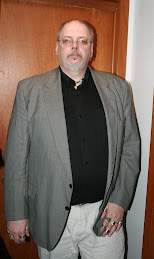DEADLY ARTISANS
Written by Jan-Michael Franklin
Pencils by Jan-Michael Franklin
Epsalon Press
The idea of a couple of badly injured agents being rebuilt with high tech augmentation is not a new idea, going back farther than the campy Six Million Dollar Man and spin-off Bionic Woman of my youth.
Jan-Michael Franklin takes the same basic premise and shifts it into high gear forcing the rebuilt agents here to be essentially a duo sent out to murder on the orders of their superiors.
Suddenly the main characters are faced with the angst of following orders which essentially has them as hit men. A nice touch indeed.
Franklin said the characters developed over time, evolving as time passed.
“As a beginning writer I think that the characters started out rather two dimensional in earlier manifestations,” he said. “My life experiences and resultant maturity allowed me to inject some depth into the story and characters for the final version. My first wife and I were in a situation with the Army where we were both stuck there. This was a big part of how Malcolm and Sierra eventually turned out. There will be more layers to the characters exposed in later stories as well.”
The influences are those that are more general than being ones he can pinpoint directly.
“It’s hard to pin down exactly what inspired Deadly Artisans (DA). I would say it was most likely a combination of things that I was really into as a kid, such as The X-Men, G.I.Joe, and various other sci-fi creations,” said Franklin. “However, more recently I would attribute the meat of the story to my experience as a criminal investigator and paratrooper for the Army.”
The art is sharp and clean, and Franklin is at his best when the agents, Stiletta and Tangent are in the ‘hero’ costumes and in full action. He can lay down the pencils on a hero action scene very well.
“Early influences are Paul Smith, and John Byrne,” said Franklin. “More recent influences are Brian Stelfreeze and Ron Garney. All of these guys put storytelling before flash, and that’s what I try to do also.”
When a creator both writes and draws a book, it is always interesting to learn which was the hardest.
“I would say that the art is definitely more labor intensive, especially since I do all of it myself,” said Franklin. “As a writer/artist these things happen mostly all at the same time. Paul Pope has a similar process, and I believe that this is the case for many creators that write and draw their own stuff.
“Artists are never 100 per cent satisfied with their work. DA is as good as I could do at this stage in my development, but I am constantly improving. This is as it should be. Artists should always be growing as artists. I don’t do this for the money, so my first thoughts are not about acceptance. I would love to get DA out to a larger audience, and as I learn more about marketing, I believe this will happen. The good thing is that these books don’t get stale. This is also my first project, so I expect constructive criticism.”
The trade paperback, which collects the four-issue mini series in a single 102-page volume is a great way to get this series. A squarebound comic takes it that extra little step closer to being a ‘real book’ (*smile).’
It is a story you are going to enjoy, and Franklin said more is to come.
“This is the first of three volumes for DA,” he said. “I’ll be doing an unrelated project before I return for volume two, but the other volumes will definitely see the light of day.”Check it out at www.epsalonpress.com
-- CALVIN DANIELS
-- Appeared on Yorkton This Week WebXtra
Tuesday, February 2, 2010
Subscribe to:
Post Comments (Atom)

No comments:
Post a Comment